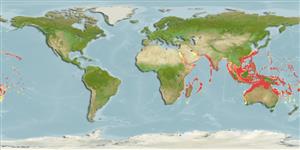Elasmobranchii (haaien en roggen) (sharks and rays) >
Carcharhiniformes (Ground sharks) >
Carcharhinidae (Requiem sharks)
Etymology: Carcharhinus: karcharos (Gr.), sharp or jagged; rhinus, an ancient name for sharks, from rhine (Gr.), rasp, both words alluding to a shark's jagged, rasp-like skin. (See ETYFish); amblyrhynchos: In honor of British zoologist John Francis George Wheeler (1900-1979), former Director of the East African Marine Fisheries Research Organization, whose 1953 account of this shark, as C. amblyrhynchos, is the first definitive record of this species [treated as a junior synonym of C. amblyrhynchos by some workers]. (See ETYFish).
More on author: Bleeker.
Environment: milieu / climate zone / depth range / distribution range
Ecologie
marien rifbewoner; oceanodroom (Ref. 51243); diepte 0 - 1000 m (Ref. 55178), usually 0 - 280 m (Ref. 6871). Tropical; 29°N - 35°S, 33°E - 151°W (Ref. 55178)
Indo-West Pacific to Central Pacific: Madagascar and the Mauritius-Seychelles area to Tuamoto Archipelago; north to southern China; south to northern Australia.
Lengte bij maturiteit / Grootte / Gewicht / Leeftijd
Maturity: Lm 128.0, range 96 - 142 cm
Max length : 255 cm TL mannelijk / geslacht onbekend; (Ref. 2334); 172.0 cm TL (female); max. gepubliceerd gewicht: 33.7 kg (Ref. 4699); max. gerapporteerde leeftijd: 25 Jaren (Ref. 37816)
Dorsale stekels (totaal): 0; Dorsale zachte stralen (totaal): 0; Anale stekels 0; Anale zachte stralen: 0. Dark grey or bronze-grey above, white below; caudal fin with a conspicuous wide black posterior margin; undersides of pectoral and pelvic fins with black tips and posterior margins, but fins otherwise not conspicuously black or white-tipped except for white-tipped first dorsal in some individuals (Ref. 9997).
Occurs on continental and insular shelves and oceanic waters adjacent to them (Ref. 244). Common on coral reefs, often in deeper areas near drop-offs to the open sea, in atoll passes, and in shallow lagoons adjacent to areas of strong currents (Ref. 244). Coastal-pelagic near the bottom, near drop-offs at 1-275 m (Ref. 58302). Forms daytime schools or aggregations in favored areas (Ref. 244). Although active during the day, it is more active nocturnally (Ref. 244). Viviparous, with 1-6 pups (Ref. 37816). Feeds on reef fishes, squids, octopi, crabs, lobsters and shrimps (Ref. 244, 5578). Tends to be aggressive under baited conditions (Ref. 6871) and readily enters into a frenzy feeding pattern, at which time it may become quite dangerous. Repeatedly incriminated in human attacks. Utilized for human consumption, fishmeal, and other shark products. Minimum depth from Ref. 6871. Maximum length of female taken from Ref. 5213.
Viviparous, placental (Ref. 50449). 1-6 pups in a litter (Ref. 244). Gestation period about 12 months (Ref. 244). Size at birth 50 to 60 cm (Ref. 26346, 37816) or 75 cm (Ref. 244). Distinct pairing with embrace (Ref. 205).
Compagno, L.J.V., 1984. FAO Species Catalogue. Vol. 4. Sharks of the world. An annotated and illustrated catalogue of shark species known to date. Part 2 - Carcharhiniformes. FAO Fish. Synop. 125(4/2):251-655. Rome: FAO. (Ref. 244)
Status op de Rode Lijst van het IUCN (Ref. 130435)
Gevaar voor de mens
Traumatogenic (Ref. 4716)
Gebruik door de mens
Visserij: van minder commercieel belang; sportvis: ja
Meer informatie
ReferentiesAquacultuurAquacultuurprofielKweeklijnenGeneticaElectrophoresesErfelijkheidZiektesVerwerkingNutrientsMassaconversie
Tools
Speciale rapporten
Download XML
Internetbronnen
Estimates based on models
Preferred temperature (Ref.
123201): 17.5 - 29, mean 27.5 °C (based on 4022 cells).
Fylogenetische diversiteitsindex (Ref.
82804): PD
50 = 0.5000 [Uniqueness, from 0.5 = low to 2.0 = high].
Bayesian length-weight: a=0.00501 (0.00297 - 0.00846), b=3.13 (2.99 - 3.27), in cm total length, based on LWR estimates for this species & Genus-body shape (Ref.
93245).
Trofisch niveau (Ref.
69278): 4.1 ±0.5 se; based on diet studies.
Weerstandsvermogen (Ref.
120179): Zeer laag, minimale populatieverdubbelingstijd meer dan 14 jaar (tm=7; tmax=25; K=0.05-0.86; Fec=1-6).
Fishing Vulnerability (Ref.
59153): Very high vulnerability (85 of 100).
Nutrients (Ref.
124155): Calcium = 5.22 [1.08, 26.72] mg/100g; Iron = 0.37 [0.09, 1.07] mg/100g; Protein = 22 [19, 24] %; Omega3 = 0.123 [0.051, 0.293] g/100g; Selenium = 56.3 [15.3, 156.2] μg/100g; VitaminA = 40.1 [15.4, 109.4] μg/100g; Zinc = 0.496 [0.237, 0.971] mg/100g (wet weight);
